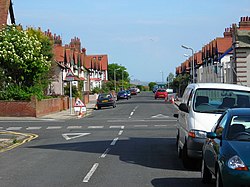Vickerstown: Difference between revisions
Created page with '{{Infobox town |name=Vickerstown |county=Lancashire |island=Walney Island |picture=Mikasa Street, Vickerstown.jpg |picture caption=Mikasa Street, Vickerstown |os grid ref=SD1796…' |
m →Development: clean up, typos fixed: open air → open-air |
||
| Line 26: | Line 26: | ||
The first 1000 houses were completed in 1901 and tenants soon moved in, despite strict selection criteria. Government subsidies meant that amenities were quickly built, along with a bridge to the mainland in July 1908. | The first 1000 houses were completed in 1901 and tenants soon moved in, despite strict selection criteria. Government subsidies meant that amenities were quickly built, along with a bridge to the mainland in July 1908. | ||
The second phase of construction occurred prior to Second World War and included an open air swimming pool and theatre. After the war, houses began to be sold on to tenants and by 1952, with only a handful of properties still under its control, the estate company was wound up. | The second phase of construction occurred prior to Second World War and included an open-air swimming pool and theatre. After the war, houses began to be sold on to tenants and by 1952, with only a handful of properties still under its control, the estate company was wound up. | ||
==Modern Vickerstown== | ==Modern Vickerstown== | ||
Latest revision as of 22:54, 27 January 2016
| Vickerstown | |
| Lancashire | |
|---|---|
 Mikasa Street, Vickerstown | |
| Location | |
| Island: | Walney Island |
| Grid reference: | SD179685 |
| Location: | 54°6’23"N, 3°15’25"W |
| Data | |
| Post town: | Barrow-in-Furness |
| Postcode: | LA14 |
| Local Government | |
| Council: | Westmorland & Furness |
Vickerstown is a town on Walney Island, Lancashire, near to the mainland town of Barrow-in-Furness. Vickerstown was developed by Vickers, the shipbuilding company, to serve the industries of Barrow and is regarded as part of the town of Barrow-in-Furness. It is an example of a planned estate built for workers by a company needing to expand.
The location Vicarstown in The Railway Series by the Rev W Awdry is based on Vickerstown.
Beginnings
The construction of Vickerstown was prompted by a lack of housing available for the workers at Barrow Docks, owned at the time by Vickers. Some workers were forced to live on board the Atlantic liner Alsaka, which was moored in the docks. Plans for its development were begun in 1898 and Vickers bought out the Isle of Walney Estates Company to handle the construction.
Homes were designed to last, with the houses in a terrace style. Larger houses overlooking Walney Channel were reserved for managers' families. The good construction of this estate meant that Barrow did not have the slums that plagued British towns in the 1950s.
Development
The first 1000 houses were completed in 1901 and tenants soon moved in, despite strict selection criteria. Government subsidies meant that amenities were quickly built, along with a bridge to the mainland in July 1908.
The second phase of construction occurred prior to Second World War and included an open-air swimming pool and theatre. After the war, houses began to be sold on to tenants and by 1952, with only a handful of properties still under its control, the estate company was wound up.
Modern Vickerstown
Vickerstown remains part of the town of Barrow and was declared a conservation area in 1988, to keep the character of the estate intact. Barrow shipyard remains the second largest employer in the town, though it is now owned by BAE Systems.
Vicarstown
In The Railway Series of children's books by the Rev W Awdry, locomotives such as Thomas the Tank Engine live on the fictional Island of Sodor, a much larger island which takes the place of Walney Island. Sodor appears to be linked to the mainland by two bridges, one road and one rail, and the town nearest this bridge is named Vicarstown. As the author was himself a Church of England vicar, this would have been an obvious choice of name.
According to the "research" into Sodor's history by the Rev. Awdry, Vicarstown was where the fictional North Western Railway first had its headquarters and according to some sources was where Thomas The Tank Engine first worked as a station pilot although some maps drawn to accompany the Railway Series books state this was at Tidmouth instead.